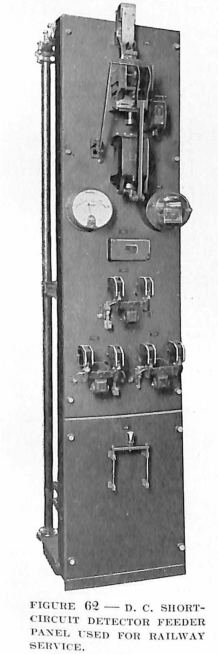No products in the cart.
Direct-Current Systems from Silent Sentinels 1924
Silent Sentinels 1924 Excerpt #8
This excerpt from the 1924 version of Silent Sentinels discusses direct-current systems. This is the 8th in the series. Follow these links to learn more about this series and the 1924 version of Silent Sentinels.
Direct-Current Systems
The direct-current systems of today, though small in comparison with the alternating-current systems, offer relay problems equally important. Comparable to the service demanded of other public utilities is that which congested cities demand from Street Railway Companies. The growth and inter-connection of some of these systems have created a demand for adequate direct-current relay protection.
This demand for service brought about both the development of service-restoring equipment and the supervision of feeder apparatus by supervisory control. Protection against overcurrents, caused either by accidental faults on feeders or lines, or by excessive overloads on lines, can be effected by the use of overcurrent relays. The short-circuit-detector type of equipment, meeting the demands of railway systems, permits heavy overloads due to acceleration, but gives protection upon the occurrence of a short circuit on the line.
 Service Restoring System
Service Restoring System
As in the case of alternating-current service, the question of continuity of service often makes necessary some sort of device to restore service after it has been interrupted. Where a feeder has been tripped out because of a fault, it may sometimes be necessary to provide means for automatically reclosing the breaker several times, allowing a definite interval of time between each reclosing. Thus, if the fault is of a transient nature and clears itself quickly, the breaker will remain closed, and service will be continued on the line. However, if the fault is of a permanent nature, the breaker will open each time it is reclosed until the specified number of reclosures have occurred, and then it will remain open permanently, indicating that the line requires attention.
Another method used for service restoring is to have a relay which has included in its design characteristics whereby it discriminates between a good and a bad feeder.
In this case, the feeder is opened under overcurrent or short-circuit conditions and the breaker reclosed automatically as soon as the excessive load is removed.
After the breaker has been opened, it may be reclosed by a resistance measuring relay. This relay determines when the fault has been cleared sufficiently to allow the circuit-breaker to be closed with safety.
When continuity of service is of great importance and when the capacity behind the feeder is large, it is desirable to have the breaker remain closed, except in cases of actual short circuits or of violent overloads. Operators of large urban railway systems demand this class of service, as it permits heavy peaks for acceleration of the cars and prevents untimely interruption of the service. Nevertheless, in meeting this demand, the feeder circuits must be protected against short-circuits and heavy overcurrents. The short-circuit-detector type of equipment provides this protection without interrupting the circuit on ordinary overloads.
Except for heavy railway service, it is usually desirable to open a circuit on a definite overcurrent. For this application the overcurrent type of equipment with an overcurrent relay is used instead of the short-circuit detector. The overcurrent setting is usually for instantaneous tripping, but occasionally a time element is provided.
Protection of Direct-Current Apparatus
The protection of the direct-current apparatus might be classed as protection against overcurrent, reversed current, and overtemperature. In most cases, such protection on motors and generators is secured by means of circuit-breakers equipped with necessary overcurrent or reversed-current coils, or by fuses of suitable capacity. In many installations, however, it is found necessary to use a protective relay in order to secure the needed accuracy and reliability of protection. In such cases, the D or the TO overcurrent relay is used, and in cases where protection is required against reverse current, the D reverse-current relay is applicable.
Overtemperature protection of direct-current apparatus is obtained in a manner similar to that described under alternating-current apparatus. The BD oil-filled thermal relay is used largely for motor protection, while in some cases where it is possible to have exploring coils in the windings the DT temperature relay is used.
Electro-Chemical Work
When a line supplies a load for such work as electro-chemical processes, where a reversal of polarity is extremely dangerous, it is sometimes necessary to supply a highly sensitive relay which serves to disconnect the circuit when any condition shows that the polarity is liable to reverse. The A polarity directional relay has been used very successfully for this purpose, fulfilling the protective requirements, and passing the under-writer’s inspection.
The sensitivity and design of this relay are such that the contacts will be closed upon any reversal of the polarity of the circuit to which it is connected, or upon a fall in the voltage to below 20 per cent of normal value.
Did you like this post?
You can share it with these links:
Read More Articles:
We Need Your Help with Our Next Protective Relay Online Training Class: Electricity 101!
